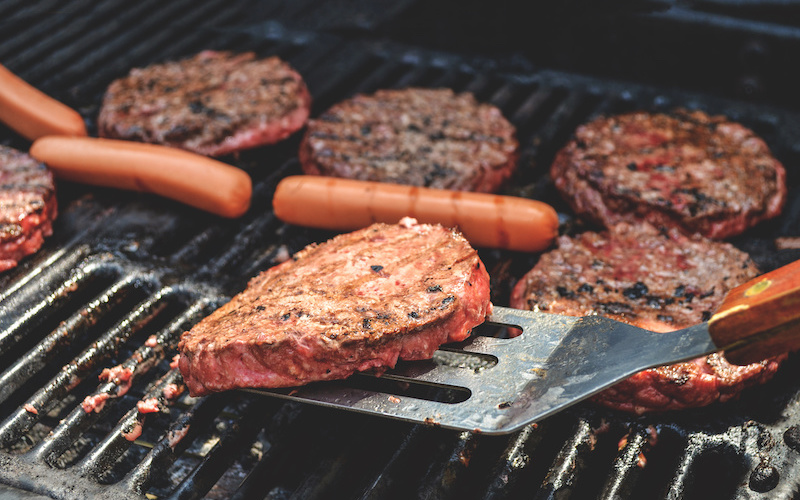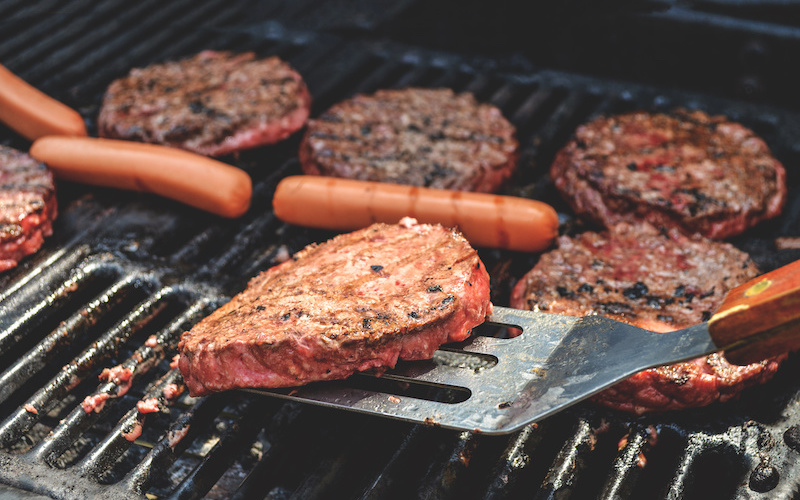For the Best Burger, A Quadruple Flip
When it comes to burgers, Jean-Luc Thiffeault likes his rare. The mathematician from the University of Wisconsin-Madison, who puts his taste preference down to his French-Canadian ancestry, has now derived a model that can determine when and how often to flip a burger on a grill to cook it to your liking as quickly as possible [1]. He notes that the model will likely appeal more to academics than to professional chefs because it treats the burger as a simple uniform slab. But, he says, it has advantages over models that consider more realistic burgers because it doesn’t require a supercomputer to perform the calculations. “It might not give exact cooking times, but it still gives some insight into the cooking process.”
Thiffeault’s study involves a mathematical “burger” whose properties can readily be analyzed. He assumes that the model’s patty has a homogeneous, solid structure and symmetric thermal properties: regardless of which side lays on the grill, heat moves upward through all parts of the 2-cm-thick burger at the same speed. He places the room-temperature burger (25 °C) on a flat surface that has a uniform temperature of 200 °C. Employing heat transfer equations, he then uses the model to calculate the optimal number of flips and time intervals between flips to ensure that the burger is cooked through in the shortest time possible—which for this study was every point inside the burger reaching a temperature of 70 °C. (This temperature would give you a well-done patty, for a rarer patty the goal would be closer to 50 °C.)
Thiffeault notes that temperature-related optimization problems typically concern themselves with an object’s temperature at some specific time. In contrast, his burger-cooking one pays attention to the temperature history of every point in the slab. Requiring that each point in a slab has at some point reached a certain temperature is very different from requiring that every point simultaneously be above that threshold, he says. “If you required that, it would be impossible to cook a burger on a grill.”
In the model, cooking a burger without flipping it takes an infinitely long time. Adding in a flip allows the patty’s top surface to start warming, bringing the total cooking time to a reasonable, finite value. Thiffeault finds that cooking time rapidly decreases with each additional flip of the burger up until four flips. After that, adding more flips provides minimal time improvement. For example, his model determines a cooking time of 80.5 s with one burger flip just under halfway through. That time drops to 65 s for four flips but only shaves off an additional one or two seconds if the flip number is upped to 20. The model shows that “after about three or four flips, it’s kind of pointless to add in anymore,” he says.
That finding will be welcome news to those grilling meat on a hot summer’s afternoon. But Thiffeault notes that even four flips may be too many for those who want to minimize their time at the BBQ. If flipping once is more your style, Thiffeault’s model shows that you don’t want to wait until the burger is half cooked before turning it over. Rather, you will want to flip when the bottom third looks done. Doing so means a longer cooking time for the second side but a shorter time overall. And with one flip, Thiffeault says, “you should get good grill marks without spending a lot of time sweating.”
–Katherine Wright
Katherine Wright is the Deputy Editor of Physics Magazine.
References
- J. L. Thiffeault et al., “The mathematics of burger flipping,” Physica D: Nonlinear Phenomena 439, 133410 (2022).





